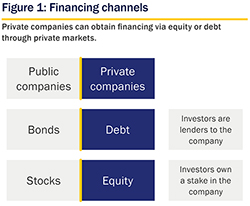Wealth Management: Investment Views – The rise of private markets

William Haggard, William Therlin, Amaya Gutiérrez, Raphaela Schröder and Andreas Doepfert, Wealth Management
Why private markets matter
Whether investing in private equity or private debt, it is important to understand why private markets matter. As illustrated by the history of the Rothschild family, investors have been acquiring or making minority investments (private equity) and lending to (private debt) privately held companies for centuries. Private markets are a well-established means of providing capital to businesses seeking to expand or manage new or existing services or operations.
Click the image to enlarge
As shown in figure 1 above, private markets are the channel by which private companies can obtain financing via equity or debt. This is equivalent to how listed companies obtain financing on the public markets via the issuance of stocks or bonds.
Private markets still have room to grow
As discussed in 'A brief history' below, private markets have grown considerably in the developed world since the 1980s. This growth has been accompanied by a decline in the number of companies listed on public markets. In the US alone, the number of listed firms dropped by half between 1996 and 2012.
Yet despite average growth of 10% per annum, popular private market strategies, such as private equity, still accounts for just one-tenth of global M&A transactions in a given year, indicating there is still considerable room for private markets to grow.
Shifting attitudes
Over the past 20 years, the growth of private markets has come hand in hand with a shift in attitudes. Becoming a publicly listed company used to be a symbol of measuring corporate success. Today, many companies avoid going public for strategic and financial reasons until absolutely necessary.
An example of this is household name and car-hailing app Uber, which has reached a potential IPO valuation of $120 billion, whilst remaining unlisted and sourcing capital from private markets.
As the nature of public market listings becomes older and more concentrated, private markets have benefited from the following three trends:
- Increased regulation, which has made accessing public markets more burdensome for companies from a regulatory perspective,1 channelling newer or medium-sized businesses towards financing solutions via the private markets
- Newer business models in turn are becoming less capital-intensive in post-industrialised economies and therefore require smaller capital investments which do not require nor warrant public market financing
- The search for higher returns. Driven by a decade of low interest rates, investors are attracted by the higher average returns available via private markets. This in turn has drawn more companies towards financing growth and development through private markets
Becoming a familiar asset class
With the rise of private markets, the asset class has become an increasingly familiar part of any wealth preservation strategy. In short, it now sits alongside other equity or fixed income investments within a multi-asset class portfolio.
Nevertheless, there are some important differences in the characteristics of private market investments, such as liquidity, yield and time horizon which one needs to understand before investing.
To explain these differences, we interviewed our Merchant Banking team in order to take a closer look at the principal trends and strategies available to clients in private markets.
A brief history
Post 1945: The birth of modern markets
Our story begins in the aftermath of World War II. The first modern-day private market firms, American Research and Development Corporation and J.H Whitney & Company were founded in order to invest venture capital in early-stage US companies. Fast forward to the 1980s and the advent of large institutional investors transformed private markets as managers began allocating parts of their multi-billion dollar portfolios in private equity for the leveraged buyouts of companies.2
What began in the 1980s as a relatively radical form of financing, associated with highly leveraged hostile takeovers, rapidly evolved in the 1990s. This happened as private markets started to focus on buyouts with an attractive value proposition for both management and shareholders and placed increased emphasis on the longer-term development of acquired companies.
Since the aftermath of the 2008 Great Financial Crisis, private markets have again come to the fore as traditional bank lending has ceased for many medium-sized businesses. In Europe, the proportion of private debt lending carried out by banks shrunk from 80% to 25% during 2008 -2018. Filling this void, private debt funds have seen assets under management triple in size in the decade after the Great Financial Crisis. Today, the breadth and depth of private markets extends beyond traditional private equity and debt investments to sectors such as real estate, infrastructure and natural resources. In addition, an active secondary market has emerged in the last two decades for investors to sell and buy exposure to pre-existing private equity assets.
With secondary market transactions growing by more than 35% year-on-year to an estimated $70 billion in 20183, private markets have become an increasingly attractive option for investors and businesses looking for financing solutions in both the developed and developing worlds.
1 For example the median time to IPO for US companies has risen from 3.1 years in 1996 to 7.7 years in 2016. Idem
2 Where a company is acquired using borrowed money to meet the cost of acquisition.
3 Pensions & Investments, Alternatives, 24th January 2019
Click here to continue: Investment Views - Understanding private equity
In this Investment Views:
-
Foreword
-
Why private markets matter (current page)
-
Understanding private equity
-
Understanding private debt
-
Managing a direct lending fund
-
Investing with Rothschild & Co
-
Important information
Download the full The rise of private markets in PDF format (1.31 MB)
